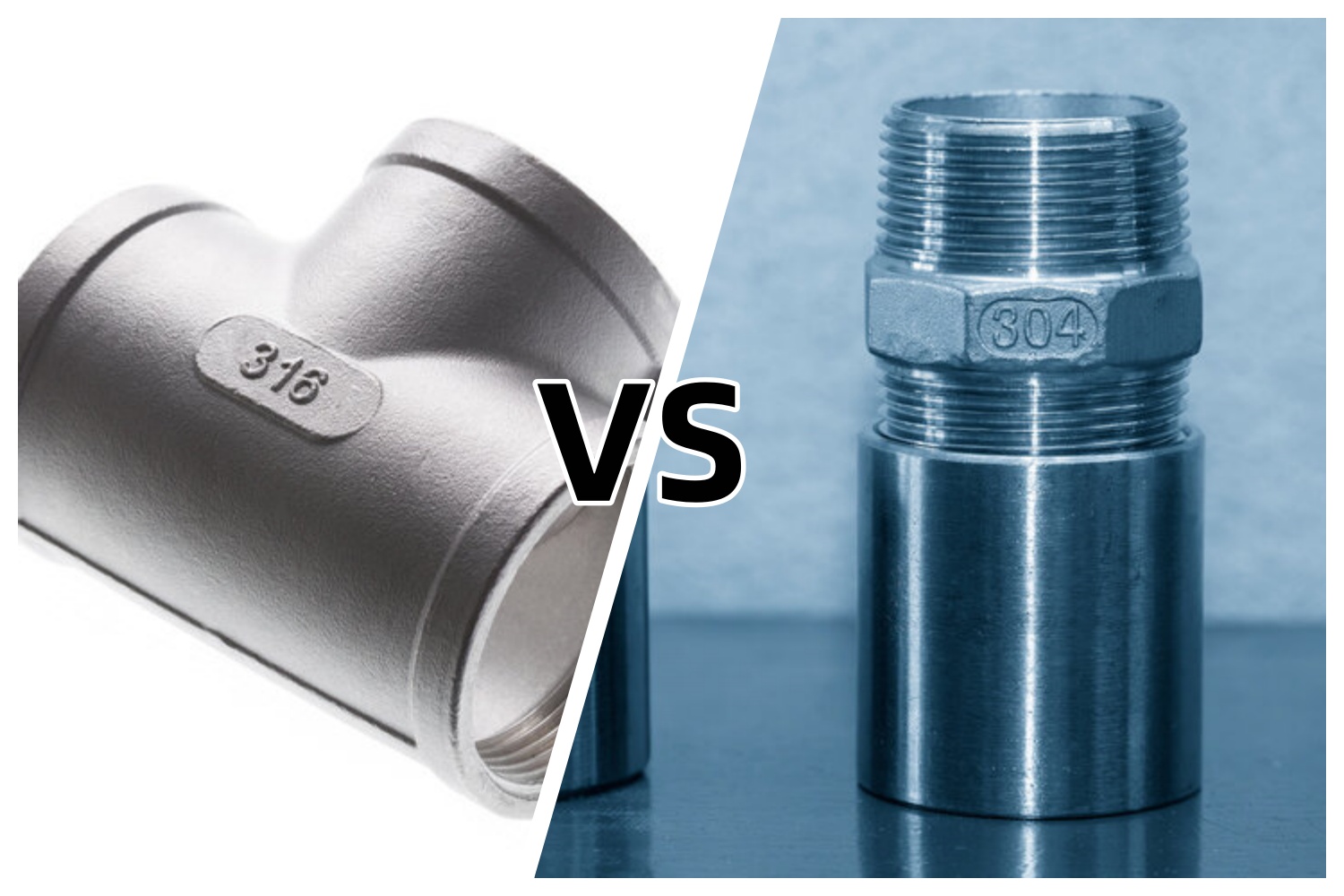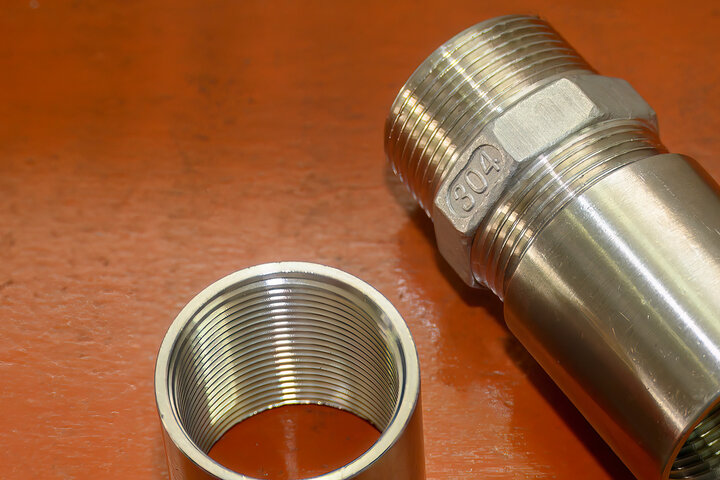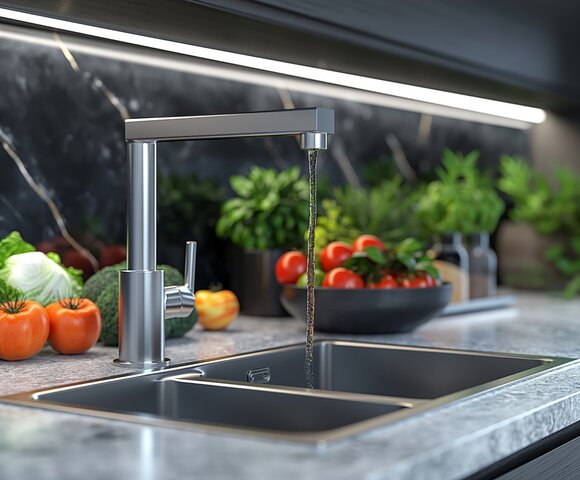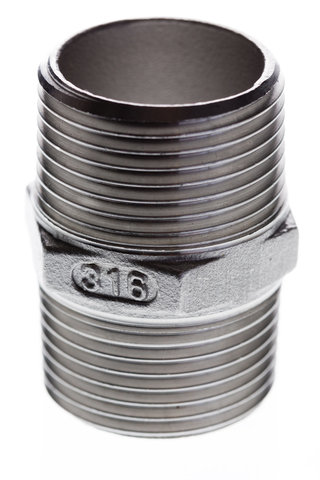Stainless steel is everywhere, from kitchenware to skyscrapers. 304 and 316 are two of the most popular stainless steels, each with unique properties for different environments. In this post, we’ll explore their main differences, covering composition, performance, and ideal applications. Discover why choosing the right grade impacts cost, durability, and resistance.

What is Stainless Steel?
Stainless steel is a corrosion-resistant alloy that contains a minimum of 10.5% chromium. This chromium content allows the formation of a passive layer, known as the chromium oxide layer, which protects the steel from rust and corrosion. Stainless steels are divided into five families based on their crystalline structure and alloying elements:
Austenitic: The most popular family, including grades 304 and 316. Non-magnetic and not hardenable by heat treatment, austenitic stainless steels offer high levels of chromium and nickel for excellent corrosion resistance.
Ferritic: Known for moderate corrosion resistance, good formability, and low cost, commonly used in automotive applications.
Martensitic: Offers higher strength and hardness, often used in cutlery and surgical tools.
Duplex: A blend of austenitic and ferritic structures, duplex steels balance strength and corrosion resistance for use in marine environments.
Precipitation-Hardening: High-strength stainless steel, often used in aerospace, due to its heat-treatable nature.
| Family | Characteristics | Common Grades |
| Austenitic | Non-magnetic, excellent corrosion resistance, good formability | 304, 316 |
| Ferritic | Magnetic, good corrosion resistance, limited formability | 430, 439 |
| Martensitic | Magnetic, high strength, moderate corrosion resistance | 410, 420 |
| Duplex | Magnetic, high strength, excellent corrosion resistance | 2205, 2507 |
| Precipitation Hardening | Magnetic, high strength, good corrosion resistance | 17-4 PH, 15-5 PH |
Among these families, austenitic stainless steels are the most widely used, accounting for about 70% of total stainless steel production. They are known for their excellent corrosion resistance, good formability, and weldability. The two most common austenitic grades are 304 and 316, which we will discuss in detail in the following sections.
What is 304 Stainless Steel?
304 stainless steel is an austenitic grade that contains 18-20% chromium, 8-10.5% nickel, and a maximum of 0.08% carbon. This chemical composition gives it excellent corrosion resistance, making it suitable for various applications.

Key Properties of 304 Stainless Steel
Excellent Corrosion Resistance: The high chromium content allows the formation of a protective oxide layer, which prevents rust and corrosion in most environments.
Good Formability and Weldability: 304 stainless steel can be easily shaped and welded, making it versatile for manufacturing processes.
High Durability: It is known for its strength and ability to withstand daily wear and tear, ensuring long-lasting performance.
Common Applications of 304 Stainless Steel

304 stainless steel's durability, ease of cleaning, and resistance to corrosion make it popular in industries like food, architecture, and household products. Common uses include:
Kitchen Equipment: Used for sinks, cutlery, and appliances due to its corrosion resistance and ability to withstand frequent cleaning.
Food Processing Equipment: Suitable for food-grade applications, including tanks, containers, and machinery, where cleanliness and rust resistance are essential.
Architectural Trim and Molding: Often seen in decorative applications, it provides an attractive finish while resisting tarnish.
What is 316 Stainless Steel?
316 stainless steel is another austenitic grade that contains 16-18.5% chromium, 10-14% nickel, 2-3% molybdenum, and a maximum of 0.08% carbon. The addition of molybdenum enhances its corrosion resistance, particularly in chloride and acidic environments, making it suitable for harsh conditions.

Key Properties
Superior Corrosion Resistance: The molybdenum content enables 316 stainless steel to withstand pitting and crevice corrosion caused by chlorides and acids.
Excellent Strength at High Temperatures: It maintains its mechanical properties even at elevated temperatures, making it suitable for high-heat applications.
Great Durability in Harsh Conditions: 316 stainless steel can withstand aggressive environments, ensuring long-lasting performance in demanding applications.
Common Applications of 316 Stainless Steel
316’s corrosion resistance and robustness suit it for demanding industries, especially where exposure to corrosive substances is routine.
Chemical Processing Equipment: Used in production tanks, pipelines, and valves to handle reactive chemicals safely.
Pharmaceutical Equipment: Ideal for medical environments, where cleanliness and resistance to chemical cleaners are crucial.
Marine and Offshore Environments: Common in boat fittings, seawater piping, and offshore structures due to its resilience against saltwater corrosion.
The Physical Properties of 304 and 316 Stainless Steel Compare
When comparing 304 and 316 stainless steel, it's important to understand their physical properties. While both grades share many similarities, there are some notable differences.
Density
Both 304 and 316 stainless steel have similar densities, around 8.0 g/cm³. The addition of molybdenum in 316 does not significantly affect its density.
Melting Point
304 stainless steel has a slightly higher melting point than 316. 304 melts at approximately 1400-1450°C, while 316 melts at around 1375-1400°C.
Thermal Expansion and Conductivity
316 stainless steel has a lower thermal expansion coefficient (15.9 x 10⁻⁶/K) compared to 304 (17.2 x 10⁻⁶/K). However, their thermal conductivities are nearly identical, with 304 at 16.2 W/m·K and 316 at 16.3 W/m·K.
Modulus of Elasticity
Both grades have the same modulus of elasticity at 193 GPa, indicating similar stiffness.
Table of Physical Properties
| Property | 304 Stainless Steel | 316 Stainless Steel |
| Density | 8.00 g/cm³ | 8.00 g/cm³ |
| Melting Point | 1400-1450°C | 1375-1400°C |
| Thermal Expansion | 17.2 x 10⁻⁶/K | 15.9 x 10⁻⁶/K |
| Thermal Conductivity | 16.2 W/m·K | 16.3 W/m·K |
| Modulus of Elasticity | 193 GPa | 193 GPa |
What Are the Differences in Mechanical Properties Between 304 and 316 Stainless Steel?
Strength
Tensile Strength: 304 stainless steel typically has a tensile strength of 500-700 MPa, while 316 offers slightly lower tensile strength at 400-620 MPa. However, both materials maintain high strength under most conditions.
Yield Strength: 316 stainless steel provides a yield strength of around 348 MPa, surpassing 304’s yield strength of 312 MPa. This difference makes 316 better suited for applications requiring higher resistance to deformation under load.
Hardness
Ductility
Elongation at Break: 304 exhibits excellent elongation at break, typically around 70%, making it highly ductile. 316, while slightly less ductile at 60% elongation, still offers strong formability for complex shapes.
Cold Formability: Both grades perform well in cold-forming applications, but 304’s higher ductility makes it more adaptable for intricate forms.
Table of Mechanical Properties
| Property | 304 Stainless Steel | 316 Stainless Steel |
| Tensile Strength (MPa) | 500-700 | 400-620 |
| Yield Strength (MPa) | 312 | 348 |
| Rockwell Hardness (B) | 70 | 80 |
| Elongation at Break (%) | 70 | 60 |
The Differences in Corrosion Resistance Between 304 and 316 Stainless Steel
General Corrosion Resistance
Stainless steel resists corrosion primarily due to its chromium content, which forms a protective oxide layer on the surface. Both 304 and 316 stainless steels excel in many environments, but 316 provides greater corrosion resistance due to its added molybdenum, which combats rust and tarnish even in harsh conditions.
Pitting and Crevice Corrosion
A significant advantage of 316 stainless steel is its resistance to pitting and crevice corrosion, particularly in chloride-rich environments. The 2-3% molybdenum in 316 creates a robust barrier against localized corrosion, making it ideal for settings where salt or acidic substances are prevalent. In contrast, 304, while corrosion-resistant, is more vulnerable to pitting in aggressive environments.
Applications in Aggressive Environments
316 stainless steel outperforms 304 in marine and acidic settings. Its enhanced resistance to saltwater corrosion makes it popular for marine equipment, while its durability against acidic compounds supports its use in chemical and pharmaceutical industries. Although 304 performs well in most non-salty, non-acidic environments, 316 remains the preferred choice for extreme conditions.
Comparison Table of Corrosion Resistance Factors
| Factor | 304 Stainless Steel | 316 Stainless Steel |
| Chromium Content | 18-20% | 16-18.5% |
| Nickel Content | 8-10.5% | 10-14% |
| Molybdenum Content | - | 2-3% |
| Pitting Resistance Equivalent Number (PREN) | 18-20 | 24-28 |
| Suitable for Marine Environments | Moderate | Excellent |
| Resistance to Acidic Conditions | Good | Excellent |
304 and 316 Stainless Steel Differ in Terms of Fabrication
Weldability
304 stainless steel is excellent for welding, adapting well to various welding processes without losing corrosion resistance. Although 316 welds effectively too, it requires more care to maintain its corrosion-resistant properties in welded areas. For demanding welds in corrosive environments, using a filler metal with added molybdenum ensures better results with 316.
Cold Work Hardening
Both 304 and 316 grades harden when worked in a cold state, which can increase their strength. Cold working allows these steels to gain toughness and strength but may require post-work annealing to relieve internal stresses.
Formability
304 stainless steel is highly formable, easily shaped into various forms without compromising strength. This makes it ideal for applications needing extensive shaping. 316 offers good formability as well, though it’s slightly less adaptable than 304 due to its molybdenum content, which can impact flexibility.
Machinability
In the annealed state, both grades are relatively easy to machine, though 304 is marginally more machinable due to its lower hardness. This makes 304 preferable for intricate parts requiring extensive machining, while 316 is more suitable where high corrosion resistance is a priority.
| Fabrication Factor | 304 Stainless Steel | 316 Stainless Steel |
| Weldability | Excellent | Good |
| Cold Work Hardening | Yes | Yes |
| Formability | Very Good | Good |
| Machinability | Slightly Better | Good |
The Cost Comparison Between 304 and 316 Stainless Steel?
304 stainless steel, often called the “standard” grade, is widely used for general applications. Its lower cost makes it a budget-friendly option for projects where extreme corrosion resistance isn’t crucial. The absence of molybdenum, found in 316, keeps 304’s price more affordable.
316 stainless steel contains higher amounts of nickel and includes 2-3% molybdenum, which greatly enhances its resistance to chlorides and harsh chemicals. These additional elements make 316 more expensive than 304, sometimes by up to 40%. The investment in 316 can be more cost-effective in highly corrosive environments, extending product lifespan and reducing maintenance needs.

How to Choose Between 304 and 316 Stainless Steel?
Selecting the right stainless steel grade is crucial for ensuring optimal performance and cost-effectiveness. When deciding between 304 and 316, consider the following factors:
Environmental Factors
304 Stainless Steel: Suitable for general-purpose applications with moderate exposure to corrosive environments. It performs well in atmospheric conditions, food processing, and mildly acidic environments.
316 Stainless Steel: Ideal for harsh environments with high exposure to chlorides, such as marine or coastal applications. It also offers superior resistance to pitting and crevice corrosion in acidic environments.
Budget Considerations
304 Stainless Steel: When cost is a primary concern and the application does not require the superior corrosion resistance of 316, 304 can be a more economical choice.
316 Stainless Steel: Although initially more expensive, 316 can provide long-term cost savings in applications where its superior corrosion resistance extends the service life of the component.
Performance Requirements
Mechanical Strength: Both grades offer excellent mechanical properties, but 316 has slightly higher tensile and yield strength.
Heat Resistance: 304 and 316 have similar heat resistance, with 304 having a slightly higher maximum service temperature.
Corrosion Resistance: 316 offers superior corrosion resistance, particularly against chlorides and acids, due to its molybdenum content.
Table of Decision-Making Factors
| Factor | 304 Stainless Steel | 316 Stainless Steel |
| Environmental Factors | Moderate corrosion | Harsh environments |
| Budget Considerations | Cost-effective | Long-term savings |
| Mechanical Strength | Excellent | Slightly higher |
| Heat Resistance | Slightly higher max temp | Similar |
| Corrosion Resistance | Good | Superior |
Summary
Understanding the differences between 304 and 316 stainless steel is crucial for making the right choice. While 304 offers cost savings and general durability, 316 provides superior corrosion resistance due to its molybdenum content. Selecting the correct grade depends on factors like the environment, exposure to corrosive substances, required strength, and budget.
Choose 304 for everyday, non-corrosive applications where cost is a primary concern. For marine, chemical, or chloride-heavy settings, 316 offers long-term performance. Considering these factors helps ensure the stainless steel meets project needs effectively.
Reference Sources
SAE 316L stainless steel
SAE 304 stainless steel
Stainless steel
Cnc Machining for Stainless Steel
Frequently Asked Questions (FAQs)
Q: What is the main difference between 304 and 316 stainless steel?
The key difference is that 316 contains 2-2.5% molybdenum while 304 doesn't. 316 also has slightly more nickel (10-13%) than 304 (8-10.5%), making it more corrosion-resistant.
Q: Why does 316 stainless steel cost more than 304?
316 stainless steel costs about 40% more because it contains additional molybdenum and higher nickel content, which are expensive alloying elements.
Q: How can I choose between 304 and 316 for my project?
Choose 304 for general purposes and indoor applications. Select 316 if your project involves marine environments, chemical exposure, or requires higher corrosion resistance.
Q: What are the typical temperature limits for 304 vs. 316 stainless steel?
304 performs well up to 870°C (1500°F) but may corrode between 425-860°C (797-1580°F). 316 works best between 454°C (850°F) and 843°C (1550°F).
Q: Which applications most commonly use each type of stainless steel?
304 is commonly used in kitchen equipment, appliances, and medical tools, while 316 is preferred for marine equipment, pharmaceutical processing, and chemical storage tanks.




















